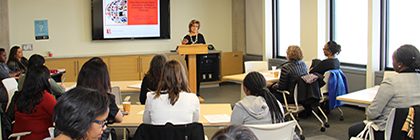The Global & Community Engagement (GCE) office in York University’s Faculty of Liberal Arts & Professional Studies (LA&PS) hosted a symposium titled Internationalizing Higher Education: Strategies, Challenges, Trends and Pathways. The symposium addressed the hot topic of internationalizing the university experience for both domestic and international students.
Issues raised at the Nov. 29 symposium indicated a need for analyzing the capacity of universities to internationalize curricula and a broader strategy at the institutional level.
 “Globalization has created the momentum for international education,” said LA&PS Associate Dean Narda Razack, GCE, in her introductory remarks. “I believe that engaging faculty members, staff and community is pivotal to achieving a more successful outcome, especially in promoting anti-imperial approaches to local and global initiatives, including study abroad experiences.”
“Globalization has created the momentum for international education,” said LA&PS Associate Dean Narda Razack, GCE, in her introductory remarks. “I believe that engaging faculty members, staff and community is pivotal to achieving a more successful outcome, especially in promoting anti-imperial approaches to local and global initiatives, including study abroad experiences.”
Razack said, “a critical inquiry into why we need an international agenda, and the benefits and challenges, is warranted as it sets the stage for embedding policies and practices.”
The symposium speakers were Jane Ngobia, assistant vice-president, Diversity & Human Rights at the University of Guelph, and York University education Professor Roopa Desai Trilokekar. These academics shared their knowledge and expertise on the dichotomies associated with studying abroad and the international student experience at an institutional capacity.
Ngobia spoke about “Internationalizing at Home,” essentially addressing how to ensure that the majority of university students – who do not study internationally – have an international experience. She identified Canada as one of the top 10 host countries for inbound international students in postsecondary education, with 97 per cent of Canadian universities offering education abroad programs. Yet only 3.1 per cent of full-time Canadian undergraduate university students participate in study abroad programs annually. Other countries have significantly higher participation rates: 30 per cent of university students in Germany, 13 per cent in Australia and 10 per cent in the U.S. study in another country.
Trilokekar presented on “Localizing a Global Policy Discourse,” discussing internationalization policies at home and abroad. At Universities Canada’s 2017 fall membership meeting, university presidents endorsed a set of principles to advance diversity, equity and inclusion on their campuses, said Trilokekar, and committed to a five-year action plan to measure their progress and outcomes. She also explored how our history shapes our understanding of international education and our relations with international students.
The lecture portion of the symposium ended by challenging the importance of labels – who is international versus who is Canadian – and informing the audience that responding to the diversity of international students and responding to the diversity of domestic students are not separate, but the same agenda.
The symposium presented multifaceted views on the need to internationalize higher education to adequately equip students with the appropriate knowledge and skills to compete in a globalized economy. The need for collaborative and transparent policies at the institutional level to promote global citizenship education was addressed, as was the need to foster a process of inclusion and to integrate internationalized curriculum in order to encourage students to look beyond the classroom and engage in cross-border endeavours.


